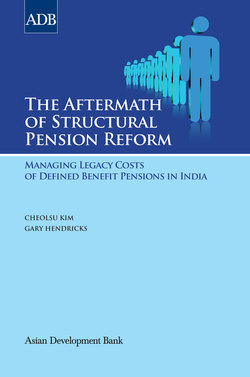The Aftermath of Structural Pension Reform

Реклама. ООО «ЛитРес», ИНН: 7719571260.
Оглавление
Cheolsu Kim. The Aftermath of Structural Pension Reform
THE AFTERMATH OF STRUCTURAL PENSION REFORM
CONTENTS
TABLE, FIGURES, AND BOX
ABBREVIATIONS
FOREWORD
ACKNOWLEDGMENTS
I. INTRODUCTION
II. CONSTRUCTING SUSTAINABLE STATE EMPLOYEE DATABASES
A. Current Record-Keeping Practices
B. State Case Studies
1. Assam
2. Bihar
3. Chhattisgarh
4. Jharkhand
5. Madhya Pradesh
C. Conclusions from Case Studies
III. CONSTRUCTING SUSTAINABLE STATE PENSIONER DATABASES. A. Current Practices for Granting and Paying Pensions
B. Creating Sustainable Databases for Defined Benefit Pension Schemes
C. State Case Studies. 1. Assam
2. Bihar
3. Chhattisgarh
4. Jharkhand
5. Madhya Pradesh
D. Conclusions from Case Studies
E. Role of Banks in Pension Administration
IV. MANAGING DEFINED BENEFIT SCHEME LEGACY COSTS
A. Developing Tools. 1. Broad Methodological Approach
2. Defined Benefit Scheme Rules
3. Assumptions
4. Compensating for Database Shortcomings
5. Benchmarking Administrative Data
B. Baseline Projections
C. Alternative Scenario
D. Exogenous Influences on Cost Rates
1. Changes in Life Expectancy
2. Trends in Retirement Age
3. Growth in State Revenues
4. Establishing a Baseline for Financial Planning
E. Government New Pension Scheme Contributions
1. Average Wages of New Pension Scheme Enrollees
2. Number of Civil Servants Covered by the New Pension Scheme
3. Cost Rates from New Pension Scheme Contributions
F. Managing Emerging Liabilities
1. Lump Sums
2. Post-Retirement Adjustments
3. Increasing the Average Retirement Age
4. Transferring Defined Benefit Scheme Employees to the New Pension Scheme
G. Need for State Action
H. Conclusions
V. IMPLEMENTATION OF THE NEW PENSION SCHEME. A. State Participation Nationwide
1. Status of State Implementation Nationwide
2. Status of Implementation in the Participating States
B. State Case Studies. 1. Assam
2. Bihar
3. Chhattisgarh
4. Jharkhand
5. Madhya Pradesh
C. Administrative Weaknesses
D. Impediments to New Pension Scheme Implementation
E. Providing Future Assistance to States for New Pension Scheme Implementation
VI. RECOMMENDATIONS
VII. CONCLUSION. A. Database Construction
B. Managing Defined Benefit Scheme Legacy Costs
C. Next Steps
About the Authors
Отрывок из книги
MANAGING LEGACY COSTS OF DEFINED BENEFIT PENSIONS IN INDIA
CHEOLSU KIM GARY HENDRICKS
.....
It is our hope that this book proves to be a valuable resource for policy makers, academics, and pension industry stakeholders, not only in India but also in other Asian Development Bank member countries, in instituting the same or similar pension reforms as those undertaken in the five states in India.
Sultan H. Rahman
.....